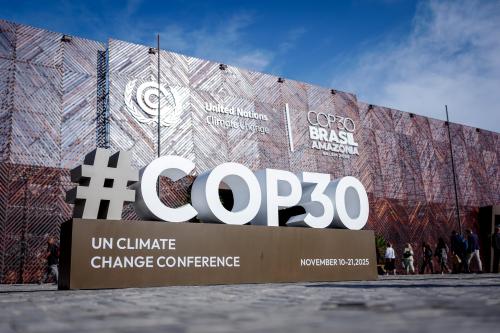President Obama will be releasing his vision for a climate change strategy on Tuesday, June 25. With just a few years until the next election and almost a year into his second term, the president will use this opportunity to set a course on this issue for the remainder of his presidency. This event is noteworthy for several reasons. First, it will give guidance to both the business and environmental communities as to what sectors and activities will be in line for changes. Second, by establishing the boundaries of the administration’s approach to climate change, it will clarify the degree to which Congress may want to legislate in new areas, such as taxation. And third, the level of ambition set by the U.S. will be an important consideration for international discussions to address climate change that are due to culminate in a new international agreement in 2015.
The road to this announcement thus far has in fact been longer than the road remaining ahead—some observers may recall that even in the presidential debates in 2008, both Barack Obama and John McCain agreed on the importance of addressing climate change and differed primarily in the degree of stringency they would apply to a policy of pricing greenhouse gas emissions. On the campaign trail that same year, Obama repeatedly returned to three priority themes that he promised to focus on during his presidency: the economy, health care and climate change. As we now know, other issues took precedence in the ensuing years, particularly after a disappointing international climate change conference in Copenhagen in 2009, and after the 2010 elections and vitriolic health care debate helped scuttle discussion of a domestic cap-and-trade program on greenhouse gas emissions.
As a consequence, Obama recalibrated his approach and maintained a low level of engagement on the issue of climate change. Most visibly, his engagement focused on energy policy, where he advocated for low-emissions technologies. His approach was most notable through his support for clean technology innovation and green jobs—which were a familiar pillar of his 2012 campaign pitch—but also manifested in a number of more technical administrative efforts that sought to establish higher standards for efficiency in transportation and electricity generation. For example, automobile fuel efficiency standards were raised significantly, from an average of 27.5 mpg to 37.8 mpg by 2016 and over 50 mpg by 2025. Nevertheless, the general hostility or disinterest of Congress has essentially precluded a more comprehensive, legislatively grounded approach. Such an approach could include features like a mechanism to tax greenhouse gas pollutants or to establish federal requirements for renewable energy or carbon content in liquid fuels.
Against this backdrop, the administration’s options are limited but by no means absent. The president has already sketched the broad outlines of his new policy, which will come in three parts: (a) reducing carbon pollution; (b) preparing for the impacts of climate change; and (c) leading global efforts to fight climate change. Obama has already discussed options in each of these categories and may reveal new ones. Taking each one in turn:
Reducing carbon pollution. It is widely acknowledged that there are negative consequences to releasing large volumes of greenhouse gases into the atmosphere, but currently doing so in most places in the world is either free or relatively cheap. The most broad-reaching and economically sound way to fix this problem is to make the cost of pollution more expensive by imposing a tax or fee on this greenhouse gas pollution. However, for many reasons (beyond the scope of this note), Obama can’t count on Congress to institute any such tax in the near term. As such, he has been looking for other ways to improve, through regulation, the efficiency of parts of the U.S. economy and to expand low-emission sources of energy supply. Such approaches could include:
- Issuing more stringent standards to reduce carbon emissions from existing power plants. While the Environmental Protection Agency has already issued aggressive rules covering new (i.e. proposed, not-yet-built) power plants that would essentially block new coal-fired electricity plants, it would be a much more dramatic effort to start regulating emissions from plants that are currently operational. Such standards have been proposed but have not yet been implemented.
- Regulating the production of high greenhouse-effect gases (such as hydrofluorocarbons) under the Clean Air Act. Because of their chemical characteristics, some gases have a much higher impact, pound-for-pound, than the standard tailpipe emissions of carbon dioxide. Because of this high leverage, reducing the net greenhouse impact of such gases can be done more cheaply than achieving the equivalent reduction in carbon.
- Improving standards to reduce methane emissions from natural gas distribution systems and from natural gas fracking. The recent “shale gas revolution” in the U.S. has contributed to domestic energy security but if some of that additional natural gas flowing through the system leaks to the atmosphere, it could have a negative greenhouse impact. Improving data collection, reporting and regulation of the U.S. natural gas system could mitigate such impacts.
- Facilitating access to public lands and offshore ocean areas for development of renewable energy technologies. Some technologies, like offshore wind technology and solar power, could be utilized on public lands and be subject to federal permitting processes. Streamlining these procedures could accelerate the deployment of these lower-carbon supply options.
- Increasing efficiency standards for new appliances. Efficiency standards are a well-tested and cost-effective method to encourage incremental technological change. A new set of standards for appliances, refrigerators, lighting and industrial equipment could generate overall economic savings as well.
- Generating new technologies through science and technology investment. Obama has been a strong advocate of targeting research and development funding toward national priorities. He could propose federal investments in innovative clean-energy technology—not only solar, wind, batteries and other new technologies, but also biofuels and nuclear energy.
Preparing for the impacts of climate change. In the climate debate, much attention is traditionally focused on the technologies and fuels that result in greenhouse gas emissions. But it is generally expected that, given the pollution already released, even now most places around the world will be subject to some changes in weather variability, trends and severity. The U.S. is expected to grapple with some such changes—in the most dramatic instance, of the kind witnessed during Superstorm Sandy—but perhaps also on a much more broad basis as well via increased drought, flood or heat events. As we have discovered countless times, reducing the toll on people, communities and property requires relatively mundane steps. Such steps include preparing and training of first responders, streamlining communication across institutions, ensuring sound infrastructure planning and good zoning decisions, encouraging healthy insurance programs, and developing and funding post-event recovery efforts. Such approaches will likely form a central part of any U.S. plan to prepare for climate change impacts.
Leading global efforts to fight climate change. Although the U.S. played a substantial global leadership role on climate change in the 1990s, its priorities have shifted elsewhere in recent years. Nevertheless, the U.S. did join many other countries in issuing a non-binding national pledge to reduce emissions in 2009, and President Obama has repeated that goal subsequently. The U.S. target of reducing domestic emissions by 17 percent from 2005 levels by 2020 is thought to remain in reach, though doing so would require an aggressive set of initiatives like the ones discussed above. In addition, the international community recently agreed to seek a new globally inclusive international agreement on climate change by 2015, and, as one of the world’s leading emitters, the degree of U.S. ambition in reaching its own goals will dramatically affect the chances of success for any such global agreement. There is one other major emitter whose participation remains uncertain but essential—China. A side agreement between the U.S. and China on their own emissions, perhaps with the participation of a few other major emerging economies, would go a long way toward bolstering the outcome of this next round of discussions. Interestingly, the U.S. has been in intense discussions with China and recently released a joint statement with China on climate change. Obama may therefore clarify his approach to the 2015 discussions as well as with respect to other big emitters like China.
It is possible that the president could present a surprise or two in the policy proposals he brings to the table on Tuesday—and one might hope he does, for even reaching our 17 percent reduction target is regrettably both uncertain given the policy levers at his disposal and inadequate given the magnitude of reductions we would need to undertake to stabilize the climate. Many climate advocates are hoping that Obama use this forum to make a clear stand against the proposed Keystone XL pipeline. This administration has made clear on many occasions their agnosticism about XL, and most indications have been that they will allow XL to be built, despite the concerns about its facilitating the import of higher-carbon petroleum from Canada. Finally, I would add one more note to watch for during Obama’s speech on Tuesday—the invocation of religious values in what Obama may argue is an obligation to “preserve God’s creation for our children and future generations.” Some people (including myself) have argued that for too long, the climate debate has been too heavily relegated to technical arguments—essentially important though they are—and too little connected to the genuine value debates that will ultimately drive policy action in this issue.
The Brookings Institution is committed to quality, independence, and impact.
We are supported by a diverse array of funders. In line with our values and policies, each Brookings publication represents the sole views of its author(s).


Commentary
President Obama’s Climate Address: What to Watch For
June 24, 2013